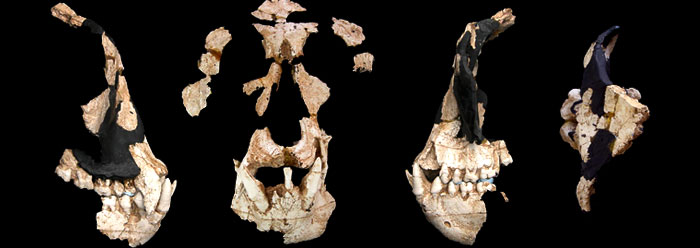Portions of a primate’s fossilized face and jaw were recovered near Barcelona in 2004. The discovery of the bones was recently hailed as “an enormous step forward in the understanding of the origin of our own family, the Hominidae.”1 But the fine print reveals that evolutionists are just walking in circles, since the tiny extinct primate’s unique features do not support an evolutionary interpretation.
In their study of the fossil, named Anoiapithecus brevirostris, published in Proceedings of the National Academy of Sciences, the researchers admitted that “the systematic position of primitive (or archaic) putative hominoids is far from clear.” In other words, it is difficult for them to place this new find into an evolutionary tree, since the order in which monkey forms are related to each other “has been subject to different interpretations,”2 with various researchers favoring widely different opinions.
This newly discovered monkey seems to most closely resemble a collection of forms referred to as Afropithecus. Unfortunately, “the position of Afropithecus and other related taxa is the most problematic” question in the ape-to-man developmental scenario,2 so the little primate really sheds no new light on an evolutionary explanation of humanity’s origins.
Although this adult male primate’s face was supposedly flatter than that of other monkeys, it had many features in common with other various forms. Anoiapithecus shares thick tooth enamel with certain apes and has certain skull features in common with another group, according to the authors. Also, it shares “an extreme reduction in the maxillary sinus,” a space inside the bone, with a third grouping of fossil forms. These features are clearly out of any evolutionary order, and the study’s authors described it as “contradictory evidence” that makes it “difficult to determine” evolutionary relationships.3
This combination of features does not fit into any particular line of evolutionary descent, but instead represents a mosaic pattern, in which characteristics are shared by otherwise unrelated creatures. A Universitat Autònoma de Barcelona press release hinted at the idea of mosaic patterns by suggesting that both this monkey’s and mankind’s flatter faces “might be a case of convergence,” where two separate species managed to evolve the same feature.1 But rather than being an example of an unlikely evolutionary coincidence, it makes more sense that this shared characteristic is the result of a Designer who used specific components in a variety of creatures to produce the needed functions for each distinct form.
Despite its confusing collection of variously shared traits, the researchers considered this fossil to be “a stem member of the great ape and human” group because of its flatter face.3 However, there is no scientific reason to conclude that Anoipithecus was anything other than an now-extinct, flatter-faced monkey designed by a Creator who incorporated various fully-formed features into its unique construction.
References
- ICP researchers describe a new hominid. Universitat Autònoma de Barceloa press release, June 2, 2009.
- Moyà-Solà, S. et al,.2009. A unique Middle Miocene European hominoid and the origins of the great ape and human clade. Supporting Information. Proceedings of the National Academy of Sciences. Published online before print June 1, 2009, accessed June 4, 2009.
- Moyà-Solà, S. et al. 2009. A unique Middle Miocene European hominoid and the origins of the great ape and human clade. Proceedings of the National Academy of Sciences. Published online before print June 1, 2009, accessed June 4, 2009.
Image Credit: PNAS
* Mr. Thomas is Science Writer at the Institute for Creation Research.
Article posted on June 18, 2009.














